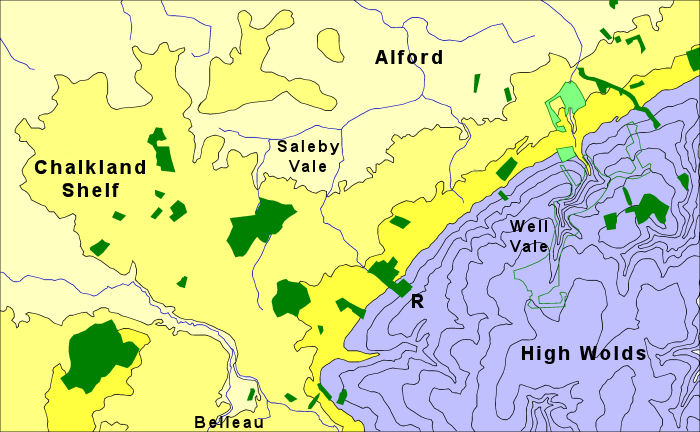
Landscape

In the above diagram, Rigsby Wood is marked 'R'. It is situated on the springline at the junction between the High Wolds and the Chalkland Shelf. A complex system of reclamation channels carries the spring waters down through a great tract of former marshland to the coast between Saltfleetby and Skegness. The largest flow comes from the Belleau Spring which forms the Great Eau. A ditch marking Rigsby Wood's northern boundary is a small spring-fed watercourse that joins others running south east through Saleby Vale to form Willoughby Great Drain at the market town of Alford.
Rigsby Wood is one of several 'woodland islands' (dark green) in farmland on this distinctive scenic margin between marsh and wold. The woodland that fills the steep-sided valley of Well Vale (light green) has been landscaped into the estates of Well Vale Hall and Claxby Grange. Fordington Wood to the west of Claxby Grange is the only substantial wood in this part of the High Wolds. But lower down to the south along the Chalkland Shelf there are other patches of woodland, notably Willoughby Wood and Welton Low Wood, and some smaller pieces around Claxby, of which Hoplands Wood is another reserve of the Lincolnshire Wildlife Trust. The Trust also owns and manages two other woodland islands off the above map to the north west, Muckton Wood and Legbourne Wood.
In terms of their biodiversity, topography and history, it is highly probable that most of these patches of woodland are the sites of ancient 'community woodlands' and the remnants of a much more extensive tree cover. Although they have been heavily replanted, sufficient remains to indicate they belong to the Eastern coppice-with-standards category, consisting of oak, ash, hazel and maple, with a field and ground flora that varies according to soil, base status and drainage conditions. The tree and shrub layers are clearly the product of past management.